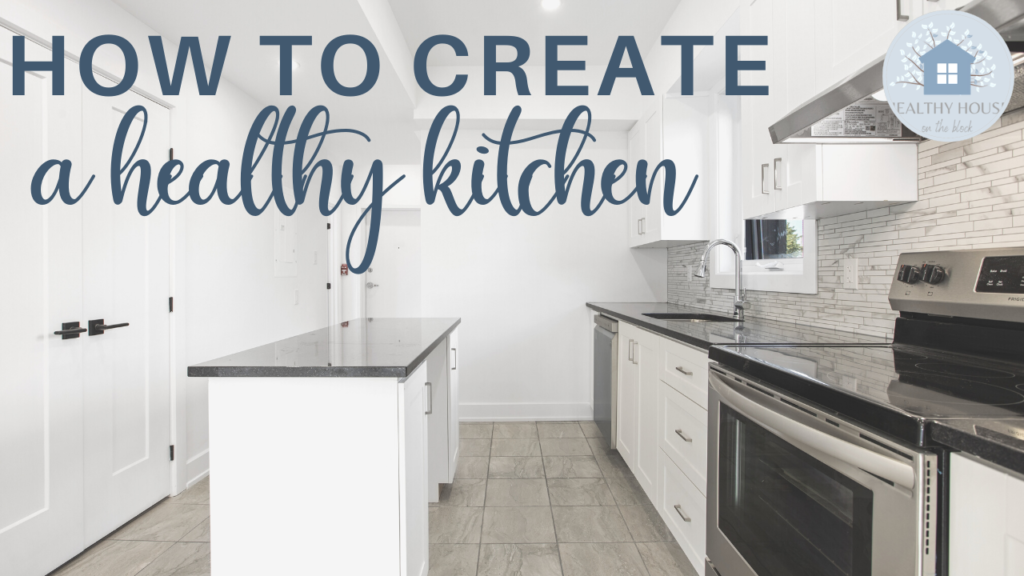
Whole food choices and healthy eating options are popping up everywhere, making it easier than ever to make positive lifestyle choices when it comes to food. We have access to healthy, natural and fresh foods more than ever before, and most health-conscious families are taking full advantage of that in their healthy kitchen environments.
The shift is bringing us back to natural and away from modified, chemical-laden options that recently graced our past. Home environment options are beginning to swing in that same way as we see people ditch harsh chemicals and unnatural synthetic products for natural and safe options.
Because, let’s face it, what good is healthy eating if the products we are cooking in and on are adding chemicals and toxins into our food. In order to have a truly healthy lifestyle, we must look at what goes into our body (food), what goes on our body (products & clothes) and what surrounds our body (our home environment).
The same idea of whole and natural food choices also applies to the environment of our kitchens, where we cook and eat. The more natural and pure the products in our kitchens are, the healthier we will be overall. And the same increasing options in natural food is beginning to make its way into the products we use to build, maintain and clean our homes. The options are increasing and there’s never been a better time to start changing your home environment to be healthier and toxin-free.
This week’s blog post is going to cover:
- The Items to Keep out of your Kitchen
- How to Create a Plan for Your Healthy Kitchen
- Habits to Make Your Kitchen Healthier
- Resources to Help Facilitate a Kitchen Detox
THE ITEMS TO KEEP OUT OF YOUR HEALTHY KITCHEN
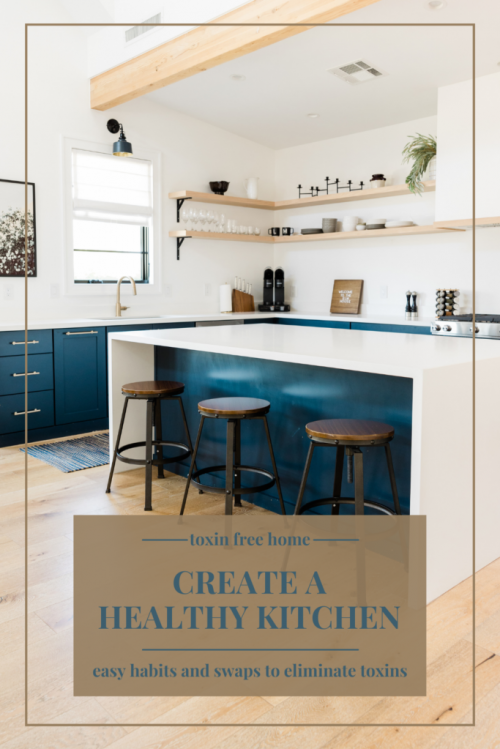
As with any space in our home, it’s important to know the items you should avoid at all costs. It can make it easier to pick and choose just how you’re going to replace items and change habits. These items are the places I start with my clients as we detox their space. The more you can remove from your home, the better and healthier the space will be. Creating a healthy kitchen should often start with removing the toxins:
Air Fresheners/Candles: Candles and synthetic air fresheners, while they smell amazing, are best left out of our homes. Candles can produce CO2, as well as introduce unwanted toxins from synthetic fragrance into our air. Air fresheners also add synthetic fragrance toxins to the air of our homes. Unfortunately we have no idea what toxins we’re being exposed to with these fragrances as there are often zero disclosures. What we do know is that many fragrance toxins fall under the “endocrine disruptor” category, which one to avoid at all costs Endocrine disruptors not only cause immediate problems with our thyroid and reproduction, long term, they can increase the risk of certain types of cancers.
Instead, try opening windows and using organic essential oils with a ceramic diffuser to add fragrance to your kitchen. These are my favorite after dinner diffuser blends to eliminate the lingering odors from cooking:
Non-Stick: This has been such a bummer, but really, there is no healthy non-stick pan out there. For a while, there were a few options that seemed good, but as they’ve studied the non-stick material more, we’ve found that it’s just not as healthy as a stainless steel or ceramic pan. Non-stick pans contain toxins in the outer layer as well as in the solutions used to adhere the material to the pan. Anytime these pans get scratched or get to a heat too high, they will emit toxins including PFOAs.
Instead, use pots and pans made from cast iron, stainless steel or 100% ceramic. This post will give you a run down of the BEST pots and pans with healthy materials. The pots and pans we cook in shouldn’t be able to leach any toxins into our food that we ingest. Ingesting toxins is one of the worst ways to come in contact with toxins, especially for children.

Plastic Food Storage: Plastic is one of those things that I’m slowly trying to remove (for good) from my own house. It can get tedious trying to remove all of it, but I think that the kitchen is the most critical place to start. Food that is warm or acidic can leach even more toxins from plastics than the alternative. Plastic toxins such as styrene or BPA or other bisphenol toxins.
And again, it’s affecting the food that we will be ingesting, which can be particularly harmful in terms of toxin exposure. Plastic food storage could range from plastic snack bags to plastic food storage containers. Slowly swapping these out for materials like silicone, glass and stainless steel will transform your kitchen in the long run.
This post will help you find toxin free materials for your kitchen and give you ideas on what you can replace and how to do it in a cost effective and efficient manner.
Toxic Cleaners & Detergents: Cleaning products are so tricky sometimes. We all want a clean and disinfected kitchen, especially when it comes to working with food. I myself have tried a gamut of cleaners around my house, and I know the tiring process of trying to find one that you actually like, is easy to find and doesn’t cost an arm and a leg.
But the importance of finding toxin free cleaners is essential to the health of your home. A healthy kitchen contains plant based cleaners that don’t introduce fragrance toxins or other disinfecting toxins to your space. Overspray from these cleaners can end up in the air on your food, causing you to inhale and ingest the toxic formula.
I personally use Aspen Clean for my multipurpose cleaner and then I used a database search to find dishwasher detergent, dish soap and heavy duty cleaners for my kitchen. Don’t forget about stainless steel cleaners or stove top cleaners too. Bon Ami is an excellent multipurpose cleaner for your sink and stainless steel.
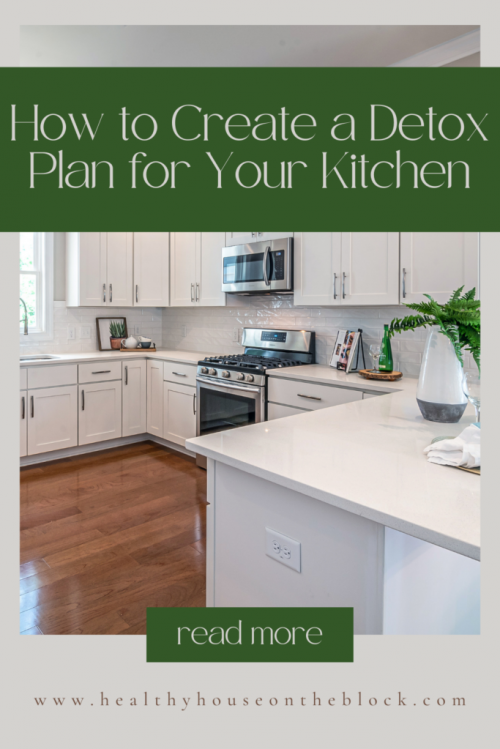
PLAN TO DETOX YOUR KITCHEN SPACE
I’m all about creating a plan when you’re looking to create a healthier space, and a healthy kitchen is absolutely no exception. I think that planning out what you’re going to change and how you’re going to change it is the best practice to stick with changes.
I use a simple document or notepad on my phone and make a short list of the things I’m going to be adjusting and changing. For example, if I were to decide that plastic was one area I wanted to tackle, I’d make a list of each category for plastic. It might look like “water bottles, kids cups, snack bags and lunch containers”
From there I would pick one of those categories and clear out the plastic if I could. If I need to replace items with healthy materials, I make that another small step to do first. And then I work on tackling one small section either each week or a couple weeks depending on the budget for replacing and the amount of free time I have.
Sometimes if I need to purchase a new item, I’ll just have in mind what I want to buy so that when I see a discount or I see a good deal I can purchase it without having to do the research at that time.
No matter how you do it, I think the best way to create a healthy kitchen is by just changing out small groups of things at a time and then removing the toxic products they’re replacing. Slow and steady definitely wins the race here.
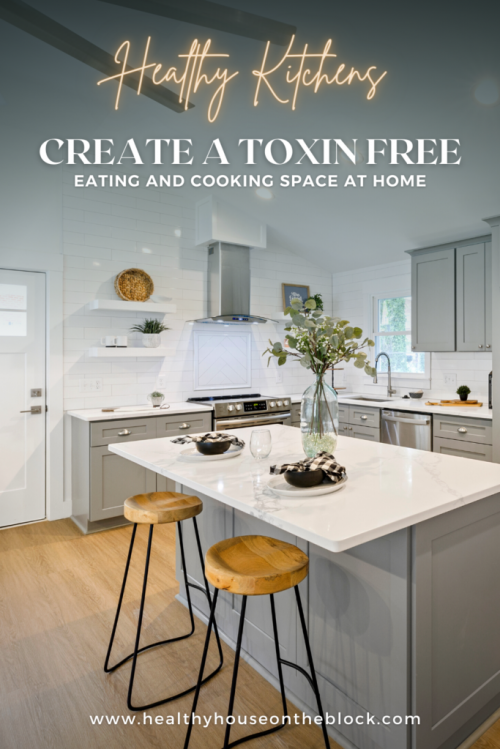
HEALTHY HABITS FOR A HEALTHY KITCHEN
Daily and lifestyle habits can either improve or hinder our indoor environments. And they can be one of the simplest things we can change about our indoor environment. The kitchen in most homes is the central hub where everyone gathers at the beginning and end of each day. Not only are we cooking our food in this room, but we spend a lot of time in this indoor environment. This is why creating a healthy space in the kitchen is a great place to start.
Cooking with Lids: Have you ever noticed how much moisture is around your stove after boiling a pot of water? Many people are surprised at just how much water vapor is produced from this simple task. But it’s a fact that just by boiling a pot of water for 10 – 15 minutes the humidity level within your kitchen can rise a dramatic 25%. You may be wondering what this has to do with the health of your kitchen. Kitchens that are high in humidity are breeding grounds for dustmites (who like a humid climate in order to reproduce) as well as a great place for mold to grow. Mold can be especially problematic in kitchens where perishable food is on countertops or cabinets.
Routine Sink & Drain Cleaning: Many of us miss cleaning our sinks on a regular basis. Sinks are a place where bacteria can be harbored and spread as food particles are left from dishes. The drain in a kitchen sink can be even more unhealthy as usually it’s a warmer area, dark and wet from water. This is a recipe for mold, mildew and bacteria. A simple solution of baking soda and vinegar (and sometimes a drop or two of Essential Lemon Oil for a fresh scent) will help keep drains clean without adding chemicals to the air.
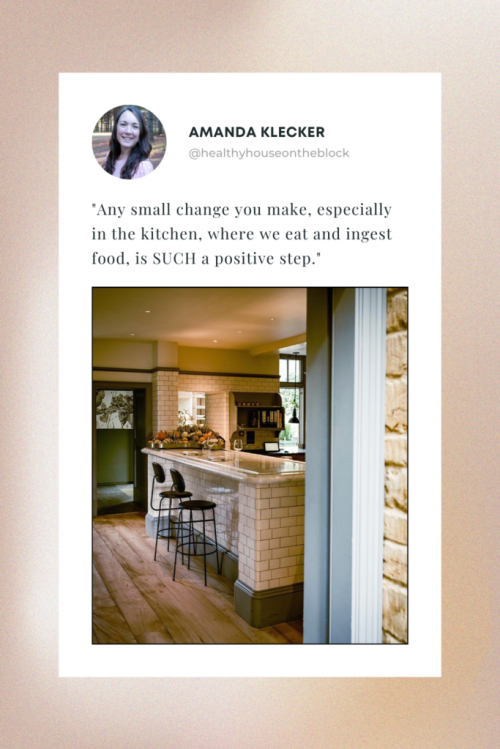
Utilizing Vents and Windows: As mentioned above, high humidity is one of the worst offenders of an unhealthy house. There are many reasons high humidity is to be avoided at all costs. First, humidity is a breeding ground for bacteria and mold. But humid environments also encourage toxins to off-gas at a faster rate as opposed to drier environments. This means the toxins present in your flooring, paint, walls and furniture. Formaldehyde and flame retardants have been known to off-gas at a much higher rate in warm and humid environments. By keeping windows open and vented fans on while cooking, you can prevent the indoor humidity from sky-rocketing around dinner time.
Frequent Replacement of Dish Towels and Rags: When’s the last time you replaced your dish towel or rags? Can’t remember? This is another area for bacteria to grow. But it is also a spot that chemicals from cleaning products can manifest. Once bacteria or chemical toxins are on the rag, it can be easily spread around your countertop surfaces and tables. Replacing the towels and rags even once a day is a great habit to start. Make sure to wash them in hot water with a chemical free detergent.
Clean That Fridge: Most of us don’t think too much about cleaning our fridge. In fact, most of us just use it for food storage and pay little attention to the remnants left behind by spills, improperly stored food and produce. While a refrigerated space can deter the growth of mold and bacteria, it doesn’t completely eliminate it. It’s important to do a routine clean with a disinfecting cleaner to remove spills, bacteria and germs from the shelves in the fridge.
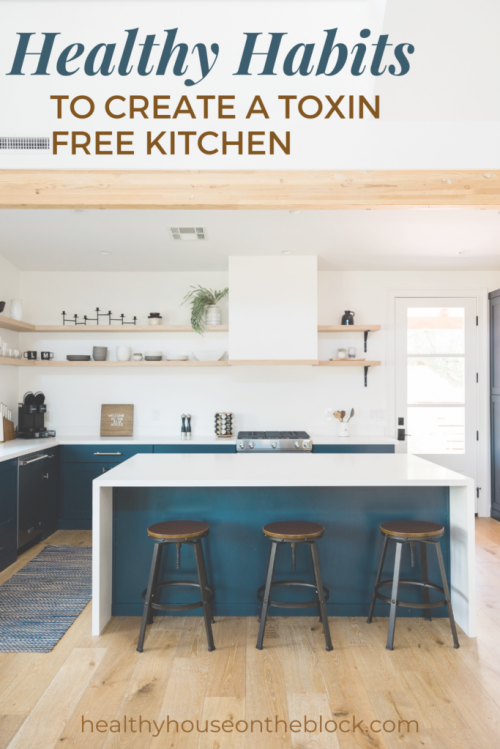
MY RESOURCES TO HELP OVERHAUL YOUR KITCHEN:
Healthy Kitchen Essentials: I’ve put together a master list of EVERYTHING you may need in your healthy kitchen. From dishes to appliances, I researched all the healthiest options and put them in one master list for you. You can even print out the checklist version to keep at home as you slowly swap out kitchen items.
Healthy Kitchen Detox: Are you ready to ditch toxins in your kitchen and start creating a healthy space to cook and entertain? My kitchen detox covers the habits and items you need to adjust and how to do it in an organized way so that you avoid the overwhelming feeling of change. I know that it can be confusing and challenging to know just what to do next, and this detox plan will walk you through it all.
Kitchen Remodel: When you’re ready to update your kitchen, there’s a lot of planning that goes into the process. Creating a healthy kitchen can sometimes be about the building materials you’re choosing. I created this non-toxic kitchen guide to help you choose things like countertops, cabinets and plumbing fixtures that are low toxin and healthy for your space.

NO matter where you start your kitchen detox, or changes, just know that you’re headed in the right direction. Any small change you make, especially in the kitchen, where we eat and ingest food, is SUCH a positive step. The more you get used to your new habits or changes, the more changes you can continue to make. Just build on each habit like a layer and before you know it, you’ll have a healthier home that supports your health and wellness.
Share this:
- Click to share on Facebook (Opens in new window) Facebook
- Click to share on LinkedIn (Opens in new window) LinkedIn
- Click to share on Reddit (Opens in new window) Reddit
- Click to share on Pinterest (Opens in new window) Pinterest
- Click to print (Opens in new window) Print
- Click to share on X (Opens in new window) X

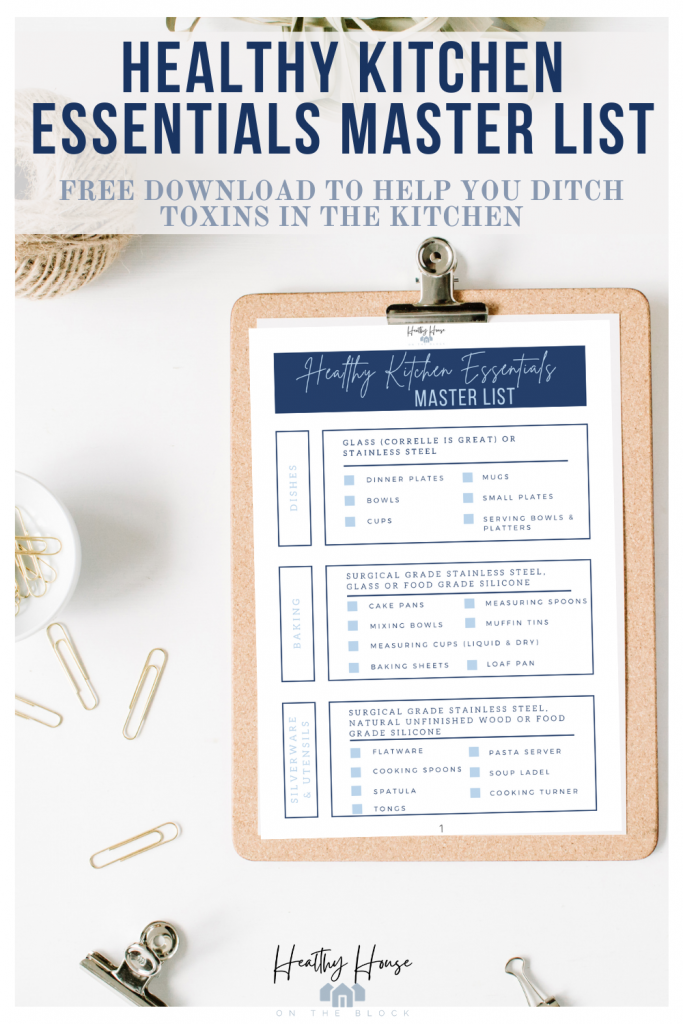




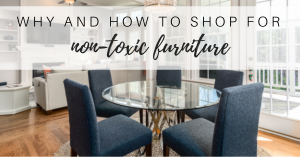
Hi Amanda, I love your channel it’s been so helpful for me. I was wondering if you can help with two things I’m so confused about? I’m thinking about replacing my rugs with vinyl flooring, there is so much out there I don’t know where to start and also bottled water, is there a safe one? Thank you for your help.
THere are a lot of options to consider! My flooring post might help, or you can schedule a consultation with me if you need additional assistance.